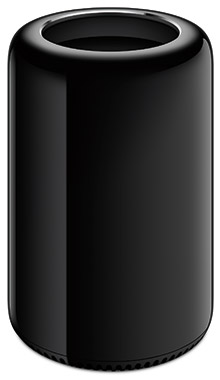 [ Please see my disclosure statement on product reviews. ]
[ Please see my disclosure statement on product reviews. ]
There are a variety of excellent performance reviews of the new Mac Pro on a variety of sites, so I decided to compare the Mac Pro with an iMac from a different perspective: video compression. What I learned surprised me, as you’ll see in this article.
EXECUTIVE SUMMARY
The purpose of this test was to judge compression speed, not image quality, in an effort to compare these two systems; though compressed image quality seemed comparable between the two systems.
When running Apple Compressor 4.1 as a bench-mark, the new Mac Pro is faster for some compression tasks and significantly slower for others when compared to a recent model iMac. If video compression is your primary use for a new computer, you may be better off buying a top of the line iMac.
Take a look at the table below. Different compression tasks yield significantly different completion speeds. Select the system that meets the needs of the compression tasks you need to accomplish.
A NOTE ON HARDWARE ACCELERATION
One of the speed advantages of the iMac is that it uses an Intel technology called “QuickSync.” This is a special processor “engine” inside many consumer-grade Intel CPUs that accelerates H.264 compression for certain encoding settings; for example, when compressing for Apple devices, QuickTime or MPEG-4 movies using the H.264 codec. The Mac Pro Xeon CPU is considered “workstation-grade,” and doesn’t provide this hardware acceleration. This explains why the iMac is faster when encoding in single-pass mode, which enables hardware acceleration, but slower in multi-pass mode, which disables hardware acceleration.
Hardware acceleration is a two-edged sword. It is MUCH faster than software encoding. However, it only yields image quality and file sizes equal to single-pass encoding. This will often be fine for movies that don’t contain a lot of movement, such as screen captures; or movies where getting it done fast is better than image quality, such as news or digital dailies. However, hardware compression is generally not the best choice for movies with lots of movement between frames or where you need the highest image quality with the smallest file size.
WHAT I DID
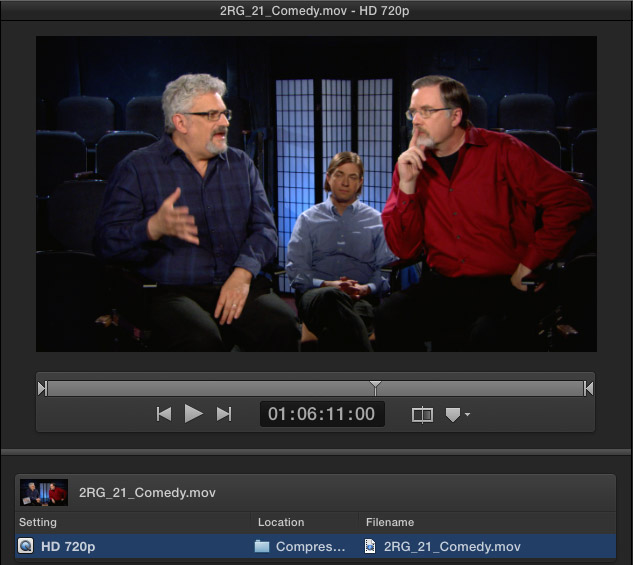
I ran a series of 21 compression tasks on both a current model iMac and new Mac Pro, noting how long the compression took and the difference in file sizes created. I used four test files:
All videos were 720p ProRes 422 or ProRes 4444 files with uncompressed audio. The audio podcast was in uncompressed WAV format.
I created nine compression test settings:
All settings matched between the two computers. Both Compressor and Mavericks were running the latest version. The Mac Pro had its latest firmware update installed.
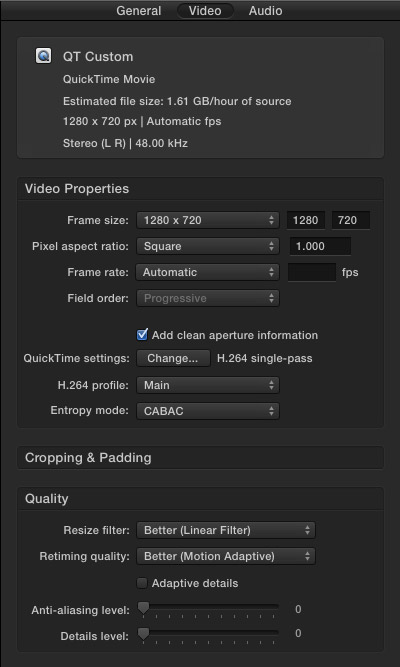
Here are the settings I used for the custom QuickTime setting: H.264 codec, 2000 kbps data rate, frame reordering on, keyframes every 90 frames.
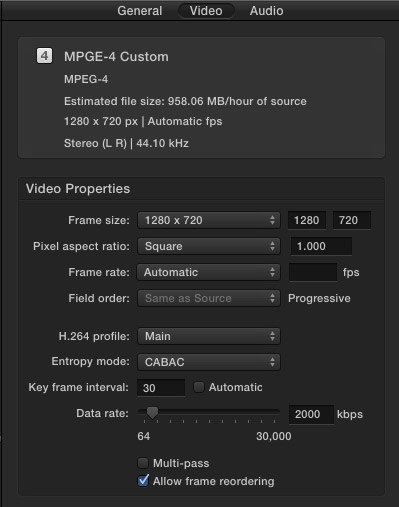
Here are the settings I used for the custom MPEG-4 setting.
WHAT I LEARNED
Compression speeds varied depending upon the length and complexity of the source files, though compressed file sizes were essentially the same between the two computers (which I would expect). All files were stored and saved to the desktop.
NOTE: As measured by the Blackmagic Design Speed Test (BMD), the Mac Pro was roughly 5 times faster at reading and writing to the desktop than the iMac. This speed differential does not seem to be significant in compression.
The BAD NEWS
The GOOD NEWS
Click the table to see a PDF of all my results.
Column definitions:
NOTE: To compare the differences in hardware acceleration between the iMac and Mac Pro, look in the Mac Pro Speed Difference column. In all but one case, the Mac Pro is slower when hardware acceleration is turned on than the iMac.
NOTES ON THE TEST
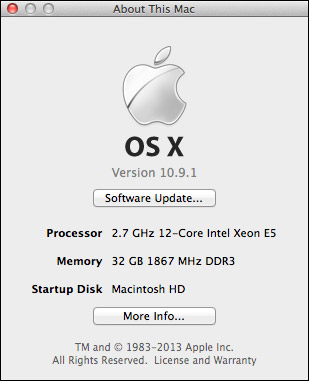
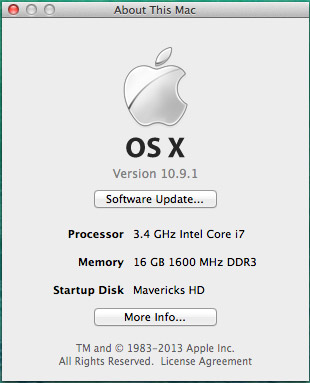
I am working with a new Mac Pro, which is on loan from Apple. (You can read my first review of it here.)
I used the same compression settings on both computers. Timings were measured by Compressor and displayed in the Completed tab. One job was fully complete before the next job started. Two jobs never ran at the same time.
Compressor was run in single instance mode, which is its default setting. Though I didn’t test for this specifically, I discovered that for short movies, single instance mode is about 20% faster than multiple instance mode. This difference disappears as the duration of the source media increases.
NOTE: Running Compressor in multiple instance mode does not guarantee faster performance. In general, I recommend leaving Compressor in its default setting with multiple instances are turned off.
Here’s an article that explains the difference between single-instance and multiple-instance mode and when to use which.
With the exception of compressing for DVD no files were resized and no filters were applied. All source files were copied to the desktop of the computer, and all compressed files were also stored to the desktop of the test computer. No network drives, or direct attached drives, were used for any part of this test.
Audio file sample rates were converted from 48 kHz to 44.1 kHz.
The same compression settings were used between the three video tests. The only difference was in the source media.
The only difference I made between the single-pass and multi-pass compression settings was checking, or unchecking, the multi-pass check box.
FINAL THOUGHTS
I was totally surprised by these findings. Until we start to see applications optimized to take advantage of the power of the Mac Pro, if video compression is your key task, a high-end iMac is your best choice.
As always, let me know what you think.
54 Responses to Mac Pro vs. iMac: Video Compression
← Older Comments Newer Comments →-
 Al says:
Al says:
January 8, 2014 at 6:56 am
-
 David Arbor says:
David Arbor says:
January 9, 2014 at 1:26 pm
-
 Marc says:
Marc says:
January 15, 2014 at 3:52 am
-
 Larry Jordan says:
Larry Jordan says:
January 15, 2014 at 7:56 am
-
Mac Pros and Cons, FCP X 10.1 | Learning to See says:
January 16, 2014 at 5:14 am
-
What Post Production Software Works Best on the Mac Pro? | Premiumbeat.com says:
January 29, 2014 at 10:58 am
-
 Joe says:
Joe says:
January 30, 2014 at 11:25 pm
-
 Larry Jordan says:
Larry Jordan says:
January 30, 2014 at 11:32 pm
-
Какие системы постпродакшена лучше всего подойдут новому Mac Pro? | FeelLab says:
February 2, 2014 at 7:49 am
-
 Arturo says:
Arturo says:
February 4, 2014 at 8:01 am
-
 David Arbor says:
David Arbor says:
February 4, 2014 at 9:48 am
-
 Henry Pantowski says:
Henry Pantowski says:
March 17, 2014 at 2:14 pm
-
 Larry Jordan says:
Larry Jordan says:
March 17, 2014 at 2:25 pm
-
 Henry Pantowski says:
Henry Pantowski says:
March 17, 2014 at 4:57 pm
-
 Larry Jordan says:
Larry Jordan says:
March 17, 2014 at 6:04 pm
-
 Henry Pantowski says:
Henry Pantowski says:
April 21, 2014 at 11:30 am
-
 Larry Jordan says:
Larry Jordan says:
April 21, 2014 at 11:48 am
-
 Henry Pantowski says:
Henry Pantowski says:
April 21, 2014 at 1:19 pm
-
Mac Pro. Test de rendimiento | salvaestudio says:
April 7, 2014 at 1:46 am
← Older Comments Newer Comments →Just bought a used but like new 2013 27″ iMac on ebay for $1900 w/2GB RAM video card 16GB RAM & fusion drive to replace my 2008 Mac Pro. Sold the Macpro for $800. Thanks for justifying my decision to pass on the MP for an $1100 iMac! I’ve not tried turning off two pass export yet, but since most work of mine goes to web and is relatively static, this ought to hold me for four more years, or until 4k crushes our i7 world. The money I saved will buy a lot of drives, or pay for my C100. Or maybe a vacation…bleeding edge isn’t always best. Lots of marketing hype in any such launch. Though I’d love to have a Mac Pro someday.
Hey Larry, so I got that 2013 iMac that I mentioned in the post above and I did a very quick, unscientific test of my own. I have presets in both AME and Compressor that are for YouTube. Both have very similar settings, however, for AME I used MP4, and for Compressor MOV H.264. Other settings were 1920×1080/29.97fps/Sq PAR/10Mbps/Progressive/Multi-pass/48kHz Stereo AAC audio.
I did 4 tests, 2 in Compressor and two in AME from the same ProRes master. The settings were as mentioned above, the only difference between the two was the number of passes.
Compressor H.264 MOV
Single-pass: 0:50
Multi-pass: 2:23
AME MP4
Single-pass: 0:24
Multi-pass: 0:37
This is really interesting, and I think it says a lot about MP4 vs H.264 in MOV, but either way, AME was way faster and there wasn’t much difference between single and multi-pass encoding.
I did try to do H.264 MOV in AME, but I swear I couldn’t find where to switch from single to multi-pass. So I did a test where everything else was the same as above, and AME did the conversion in 57 seconds. I don’t know if that’s CBR, VBR 1, or VBR 2 pass.
Anyway, I’d love to see something more scientific because every time I try to compare AME to Compressor, it always seems that AME wins in terms of speed.
Dera Larry,
Did you ever made a test of “clustering” and it’s result in compression speed for something like an hour of video and audion in proress 422?
Marc:
Yes, as part of my new Compressor 4.1 training:
http://www.larryjordan.biz/app_bin/Store/catalog/product_info.php?products_id=344
However, I have not yet written an article about this yet.
Larry
[…] Larry Jordan testing Mac Pro vs. iMac Compression Speeds (link aded 1/15/14) […]
[…] Jordan has two interesting articles on video compression on the Mac Pro. In this first article he compares it’s performance to an iMac, performing a plethora of tests with different types of video content, codecs and lengths. You can […]
Larry,
incredible.
This is an iMac AGAINST a 12 core? I mean I will miss the ports and I would LOVE to get the new mac pro… But it seems like the new Mac Pro… I am paying for the future… as if the software just hasn’t written code to utilize all of that Bandwidth. Because theoretically it should be exponentially faster… Not just 1/3 faster…
Still I will I had the money for the mac pro..
I am setting up a low budget color correction suite… and I want it all. But I have to spend some money on the CC monitor and maybe an i/o from black magic..
Joe:
You have it exactly right. The software industry is in the very early stages of optimizing for this machine. By the end of the year, I expect the Mac Pro to win handily. But, for now, its a close race.
larry
[…] касательно сжатия видео и Mac Pro. В первой статье он сравнил производительность Mac Pro и iMac, проведя массу тестов с различными типами видео, […]
Hello I would like do the right thing to replace my old MacPro 2×3,2 Quad Core Xeon, 8Gb Ram and GeForce 8800 GT.
At present I can spend just 3.500, have I to get basic MacPro model, top end iMac or top end MacBook pro retina?
Just to edit HD footage on FCP and Avid, no 3D, neither After Effects or simila composition tools.
Arturo, if that’s the kind of work you’re doing, you could buy a high-end iMac and a nice Thunderbolt RAID. You don’t even need the top tier iMac, but it’s nice. I have the fastest processor, 24GB of RAM (I bought the extra RAM from OWC), the 4GB graphics card, the 1TB Fusion Drive, and some accessories for under $3000. For that price you could also get a $400 or $500 Thunderbolt RAID from LaCie or G-Tech.
Larry, I would appreciate if you could respond to the following question:…does your iMac’s specified configuration might handle working with some stuff while using either AE or Motion’s latest update?…
would appreciate your response…thanks
Henry:
I’m a bit confused about the phrase “might handle working with some stuff”.
However, if you are asking whether the iMac is suitable for After Effect and Motion, the answer is yes.
Larry
Greetings Larry. What I meant by saying “might handle working with some stuff” was if the iMac could handle the usage of filters in AE as well as in FCPX, and or multicam projects with ease while rendering or doing composing within Motion.
The fact of the matter is that your article Mac Pro vs. iMac: Video Compression, has broaden the idea I had when it comes to iMacs, being a Mac Pro user for as long as I remember. And since I have been trying to make up my mind as to what system I might be buying soon, I even thought of buying a refurbished aluminum Mac Pro newer than the one I already own.
My budget is a bit tide at the moment, so reading your article has made me think that I should consider the iMac as a possible replacement instead of an already, though newer, Mac Pro.
I appreciate your prompt answer to my previous post. Thanks
Henry:
For most applications, an iMac with a high-end GPU should be fine for most tasks. Clearly the Mac Pro will be faster due to its architecture, but when budgets are tight, the iMac is a great choice.
Larry
Larry…Curiously I have found this interesting topic at MacRumors regarding the iMacs http://forums.macrumors.com/showthread.php?t=1724533…and I would love to hear your impressions on the matter.
Maybe you have heard of all this but it surely has been new to me.
Any thoughts on this?
Thanks
Henry:
Hardware rumors are always fun to read. But, I can’t purchase a rumor. For me, the only thing that matters is the shipping product. Until a system is released, we don’t know what it can actually do or what it will actually cost.
Larry
Indeed Larry, you are correct, seems I have never learned my mom’s lesson to “never put the wagon before the horses”…
But shall will say….indeed. Best regards
[…] de estas pruebas Larry Jordan hizo las suyas mucho más […]